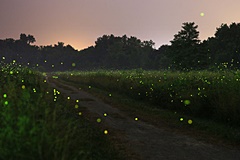
Welcome to Hemlock and Canadice Lakes!
Barns Businesses Cemeteries Churches Clinton & Sullivan Columns Communities Documents Events Time Line Fairs & Festivals Farm & Garden Hiking Homesteads Lake Cottages Lake Scenes Landscapes Library News Articles Old Maps Old Roads & Bridges Organizations People Photo Gallery Podcasts Railroad Reservoir Schools State Forest Veterans Videos
|
“Nature in the Little Finger Lakes” by Angela Cannon Crothers |
|
|
What Glows in the Night By Angela Cannon Crothers July 2015 Night buzzes. Night blooms. Night unravels its mystery in long threads of conversations, each connected to the inner workings of the nocturnal world in an afterglow all its own. A light show still pulses in tall grasses and forest edges here in the Little Finger Lakes Region, as if someone were sprinkling glitter there. Lampyridae is the Latin name of a family of true beetles we know as lightening bugs or fireflies. There are thousands of species of fireflies but not all of them produce a luminescence. The blinks of bioluminescence derive from a chemical reaction between oxygen and luciferin in special cells in the beetle’s abdomen. Scientists are still learning about this cold light reaction that produces almost no heat. If you spot a lightning bug flying and flickering about in the darkness, it is probably a male. Females sit like indifferent wall flowers, observing the mating show and blinking back only if interested. Different species of lightning bugs create different patterns of blinks to attract a mate. Sometimes I try counting the beat of their flashes, trying to ascertain the mysterious rhythm they go by, but I can’t quite get the beat, then again, I’m not a firefly. And although there has been some research done regarding “false calls” by females to lure in males of other species for prey, most adult lightning bugs feed only on nectar and pollen. In the summer weeks to come, some of their hatched larvae—the glowworms—will glimmer on the ground. There are other Kingdoms of life on earth that produce bioluminescence; certain species of fungi also contain luciferin; species of Armillaria, Panellus, and Omphalotus olearius (known fittingly as the Jack-o’-Lantern mushroom) and a few others. These bluish-green lit mushrooms are referred to as Foxfire. Foxfire can be found glowing dimly or brightly on both down, rotting timbers, and upright trees. The original folkloric name stemmed from “Fairy Sparks” and “Fairy Fire” and was morphed linguistically to Foxfire, where other legends evolved. A porch light in the darkness calls in numerous night flying insects confused by the earth bound glow. Nocturnal insects navigate using the moon and stars as overhead guides and are still adapting to humankind’s explosive transition to electric lights. Slender bodied, spritely green colored Green Lacewings are common at night as are the softly scaled wide wings of moths. In early July you may find visitors with 3- to 5-inch wingspans from the Cecropia, Polyphemous, and Silk Moth families; among them, the near luminescent green of the Luna Moth. Equally large but narrower in wingspan are a variety of Sphinx Moths who swoop and buzz in flight; hence their other names as Hawk Moths and Hummingbird Moths. There are Underwings and Tussucks, Geometers and tiny, tiny Casemakers—several thousand species of moths in all. Some nectar feeding and rolled tongued species will seek out the tall stalks of night blooming evening primrose and other blooms. Other species lack mouth parts and are just looking to mate and lay eggs on a favorite host tree for their voracious young to chow on leaf by leaf. Still others will be mesmerized by the light of a porch, a gas station, or highway lamp post, and dance the night there, forgetful of their purpose. The eerie spots of eye shine via headlights or flashlight give us clues as to the wildlife that share our environment. Humans do not produce the reflective light in the back of our retina, and although there is some discrepancy amongst viewers in general, white or bright yellow eye shine are most likely deer or raccoon and possum—depending on the height at which they are seen. Golden, dull yellow are coyotes or dogs. Taking out a flashlight and looking closely in the grasses and forest leaves you can even find brilliant tiny red or green eye shine from spiders, or the slightly larger red shine from rabbits. Nighttime’s great master of the hunt, the owls, may be red for a small Screech Owl, or large bright yellow with black pupils of the Great Horned Owl. The hours of darkness are alive and lush with activity, the sounds of soft wings, croaks, cackles, hoots, buzzes, whirs, gnawing, and all the stuff of life... many with a glow all their own.
|
||
|
Editor’s Note: Angela Cannon Crothers is a naturalist and writer who teaches at Finger Lakes Community College and with The Finger Lakes Museum. Here are some columns that she has written about the Little Finger Lakes. Her columns also appear in the Lake Country Weekender newspaper.
|
||
